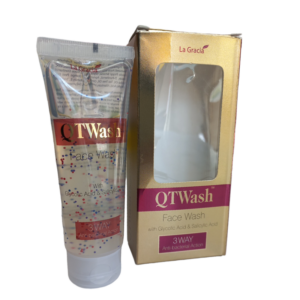SALICYLIC ACID + GLYCOLIC ACID
Salicylic Acid: Salicylic acid is a medication commonly used for its keratolytic properties, meaning it can help to soften and remove the outer layer of the skin. It is primarily used in the treatment of various dermatological conditions, including acne, psoriasis, warts, and corns.
The mechanism of action of salicylic acid involves its ability to exfoliate the skin by penetrating and breaking down the protein “glue” that holds dead skin cells together. This helps to unclog pores, reduce inflammation, and promote the shedding of dead skin cells.
Salicylic acid comes in different formulations, including creams, gels, and even medicated patches. The concentration of salicylic acid can vary, typically ranging from 0.5% to 5%, depending on the intended use and severity of the condition being treated. It is important to carefully follow the instructions provided by a healthcare professional or the product label.
Possible side effects of salicylic acid may include skin irritation, redness, dryness, and peeling. Some individuals may also experience a stinging or burning sensation upon application. These side effects are usually mild and temporary, but if they persist or worsen, it is recommended to consult a healthcare professional.
It is essential to avoid applying salicylic acid to broken or irritated skin, as it may cause further irritation. Additionally, individuals with known allergies to salicylates should not use salicylic acid products. It is always advisable to consult a healthcare professional before starting any new medication or treatment.
Glycolic Acid: Drug: Glycolic Acid
Use: Glycolic Acid is a medication commonly used in dermatology for various purposes, including skin rejuvenation, treatment of acne, hyperpigmentation, and fine lines. It is also utilized as a chemical peeling agent to enhance the appearance and texture of the skin.
Mechanism of Action: Glycolic Acid is an alpha-hydroxy acid (AHA) that works by exfoliating the outer layer of the skin. It penetrates the skin and helps in removing dead skin cells, promoting cell turnover, and stimulating collagen synthesis. These actions result in a brighter complexion, improved skin texture, and reduced signs of aging.
Dose: The dosage and application method of Glycolic Acid can vary depending on the intended use and the specific product being used. It is available in various formulations such as creams, gels, lotions, and chemical peels. It is important to follow the instructions provided by the healthcare professional or the product packaging.
Side Effects: Common side effects of Glycolic Acid may include temporary skin irritation, redness, peeling, dryness, and a mild stinging or burning sensation at the application site. These side effects are usually mild and resolve on their own with regular use. However, if severe or persistent irritation occurs, it is advisable to discontinue the medication and consult a healthcare professional.
Precautions: Prior to using Glycolic Acid, it is essential to inform the healthcare professional about any allergies, skin conditions, or medications currently being taken. It is also important to avoid excessive sun exposure and use broad-spectrum sunscreen while using Glycolic Acid, as it can increase sensitivity to sunlight. Pregnant or breastfeeding individuals should consult their healthcare provider before using Glycolic Acid.
Overall, Glycolic Acid is a widely used medication in dermatology for various skin conditions. Although it is generally safe and well-tolerated, it is always advisable to consult a healthcare professional for appropriate use and to discuss any potential risks or concerns.

